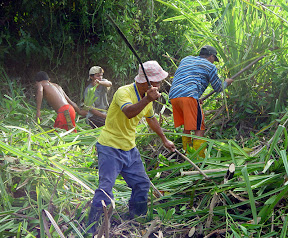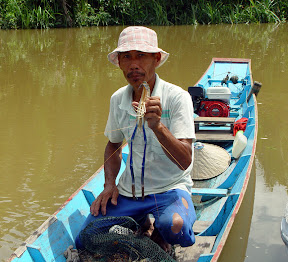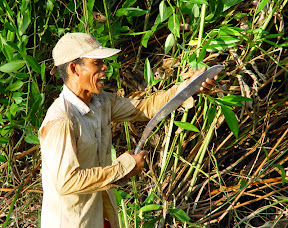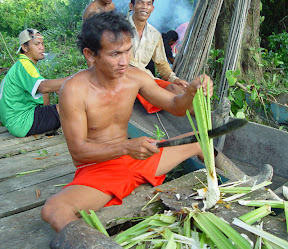 A rickety elevated plank-walk connects the nearby longhouse to the river, crossing wet padi fields and pushing through a jungle margin at the river bank. That jungle is constantly trying to claim back the plank-walk, along with the weeds and grasses in the fallow padi fields. One afternoon last week the entire male population of the longhouse appeared, all armed with long knives. They slashed their way from the longhouse to the river, clearing a wide swathe through
A rickety elevated plank-walk connects the nearby longhouse to the river, crossing wet padi fields and pushing through a jungle margin at the river bank. That jungle is constantly trying to claim back the plank-walk, along with the weeds and grasses in the fallow padi fields. One afternoon last week the entire male population of the longhouse appeared, all armed with long knives. They slashed their way from the longhouse to the river, clearing a wide swathe through the undergrowth.
the undergrowth.Next day the job continued, and only then did we discover what was really happening. It seems that many of the local long-boats have not been out of the water for some time (some for more than twelve months), so they need to be dried out and re-painted.
Our friends were busy clearing a hard stand area, though on this flood prone river bank you'd have to call it a "soft" stand. The boats will be floated up on a high tide, and then lifted clear of the
 mud
mud onto simple wooden supports. After several days drying they'll be scraped, painted and launched again. The river tides here are rarely less than 2.5 metres, and often run to more than 5.0 metres, so finding a really dry spot is difficult - even the long houses are built on stilts to allow for the periodic flooding.
onto simple wooden supports. After several days drying they'll be scraped, painted and launched again. The river tides here are rarely less than 2.5 metres, and often run to more than 5.0 metres, so finding a really dry spot is difficult - even the long houses are built on stilts to allow for the periodic flooding.These Iban river craft are a curious mix of modern and traditional design. Long and narrow, with natural "grown" knees re-inforcing the chines, they are easy to paddle and fast under power. Our good friend Jampie has a nice little single cylinder (4 stroke) Honda engine powering his boat, complete with a 1/4" stainless shaft and 6.5"dia. alloy propeller. However when he set out to build the boat he headed up river to a
 virgin jungle area - there he selected and felled a suitable tree and sawed the planks in the field, whilst living rough. After a couple of weeks he was able to head back down river with an almost completed boat .... traditional skills survive.
virgin jungle area - there he selected and felled a suitable tree and sawed the planks in the field, whilst living rough. After a couple of weeks he was able to head back down river with an almost completed boat .... traditional skills survive. Thats Jampie in his boat at right (above), showing the dinner he'd caught for us - a giant freshwater prawn. As the jungle was cleared, we noticed that the felled "Rasau" palms were being collected. Everyone was energetically extracting the heart of the central stalk, which is sliced and cooked in a light curry.